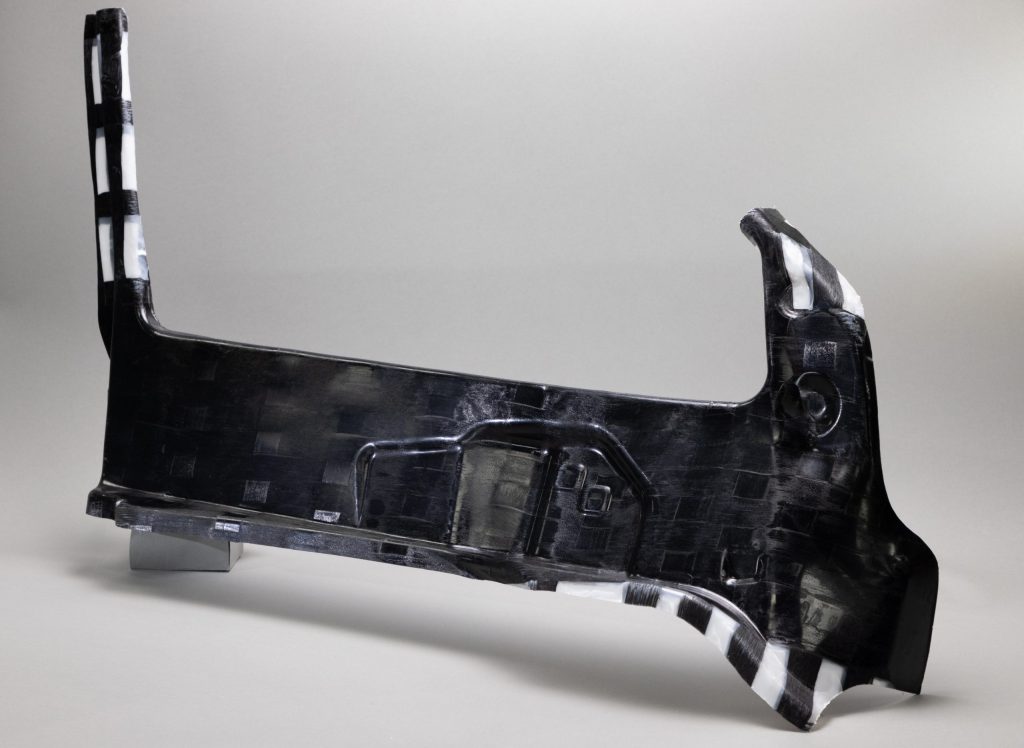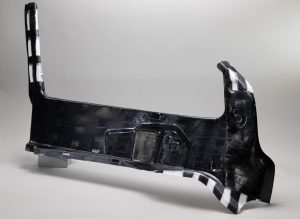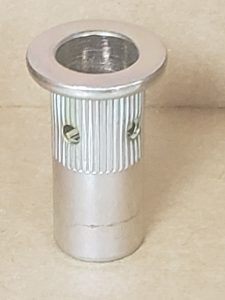

Automotive Innovations
During General Motors Composites Technology Days in August, ACMA members showcased breakthrough products to GM designers, engineers and decision makers. Here are a few of the solutions presented.
Lattice Structures
Replacing traditional solid laminates with a customized lattice structure in composite automotive body panels could potentially save OEMs money and reduce vehicle weight.
The technology, developed by materials supplier WEAV3D, starts with an open, continuous fiber lattice made from unidirectional thermoplastic prepreg tapes. The component manufacturer adds a long fiber and/or short fiber reinforced polymer substrate to the lattice structure to define the part’s shape and thickness. The lattice can be laminated to the substrate in a separate process or co-molded with it through thermoforming, compression molding or injection overmolding.
Adjusting the lattice’s weave density and/or tape types provides the necessary properties in different regions of a component. “By changing the lattice variables, we are able to locally tailor the stiffness, the strength and the toughness of the final part,” says Chris Oberste, WEAV3D’s president and chief engineer. A lattice-reinforced substrate can be up to 25 times stronger and 35 times stiffer than the substrate alone, according to Oberste.
The lattice structure also offers the potential for multifunctionality. For instance, a conductive metal ribbon or foil placed in the lattice can handle the energy transfer capabilities for heatsinking or LED lighting, eliminating the need for a wire harness. That saves weight and reduces parts.
WEAV3D recently partnered with Braskem and Clemson University to improve a composite car door’s beltline stiffener. “We replaced the organosheet material with lattice-reinforced polypropylene, reducing cost, weight and waste,” says Oberste. “While this is not intended to go into a production vehicle today, it is based on production vehicle design requirements and demonstrates the potential for the technology.”
Composite Hinges
A CFRP flexible drive shaft with virtual hinges could one day be used in vehicles to overcome the limitations of current drive shaft assemblies.
Duncan Lawrie, president of Lawrie Technologies Inc. (LTI), has worked for 15 years to improve drive shafts, which transmit the torque provided by the diesel engine or electric motor to the wheels. Drive shafts can become misaligned due to the motion of the wheels and transverse axles.
OEMs currently address this problem with flexible couplings, such as universal joints, which are bolted to the drive shaft at each end. These connections require lubrication to avoid fretting corrosion, as well as rubber boots that seal the joints to maintain the lubrication. While the solution addresses misalignment, adding extra parts – the joints and rubber boots – increases the weight of the vehicle.
LTI’s CFRP drive shaft eliminates these problems with integrated flexible couplings made via a precise filament winding process. “These virtual hinges behave like diaphragm couplings but don’t have to be bolted together because the assembled flexible shaft is all one piece,” Lawrie says. This reduces the number of parts required for a drive shaft assembly and decreases installation time and required maintenance.
Lawrie says the CFRP drive shaft is inherently balanced and can be designed to meet the desired specifications for natural frequencies, torsional buckling and allowable misalignment. The optimal geodesic path of the carbon fibers prevents hysteretic heating – even at high misalignments – and provides for infinite fatigue life.
LTI has successfully tested the flexible drive shaft in a prototype aircraft and 6,000-horsepower seawater pumps. Although the cost is currently too high for low-volume automotive production, Lawrie believes the technology could be competitively priced for runs of 10,000 units or more.
Joining Rivet Nuts
Joining automotive composite components when only one side of a hole is accessible can be challenging. When the blind rivet nuts currently used are inserted and tightened, their sleeve collapses and expands against the inside of the hole to hold it tight. This works fine for metal parts but not for composite parts.
With soft composites, the radial expansion of the sleeve may push the material aside so that the bolt expands inside the hole rather than behind it. With harder composites, the pressure of the expansion can cause microcracking and eventual deterioration of the hole, resulting in joint failure.
To overcome these problems, automakers may bond nuts or spacers to the parts before using the bolts. However, these take extra time to install and frequently fall off. Vehicle designers may insert steel brackets at the joining points or thicken the composite material near the hole to prevent microcracking. But both approaches add unwanted weight.
BBA Fasteners developed steel and aluminum rivet nuts with bulge control technology (BCT) as a lighter, faster and more effective alternative. “The BCT fastener has four holes at 90 degrees to each other. When the tool goes into the rivet nut and pulls upon it, it weakens the fastener so that it forms a bulge at a predetermined point,” says Tim Bartlett, CEO, BBA Fasteners. The bulge spreads out wider than a collar, reducing the risk of microcracking and hole failure.
Although BCTs are not commonly used in North America, Fiat and other European OEMs have used them in vehicles for years. In the U.S., electric vehicle companies are now incorporating them in their new vehicle designs.
Mary Lou Jay is a freelance writer based in Timonium, Md. Email comments to mljay@comcast.net.

The lattice structure for this beltline stiffener component is made of glass fiber and carbon fiber reinforced polypropylene unidirectional tapes, then laminated on either side of an unreinforced polypropylene sheet.
Photo Credit: WEAV3D

The BCT fastener is designed to form a bulge at a predetermined point, limiting microcracking around the hole in joined composite components.
Photo Credit: BBA Fasteners

SUBSCRIBE TO CM MAGAZINE
Composites Manufacturing Magazine is the official publication of the American Composites Manufacturers Association. Subscribe to get a free annual subscription to Composites Manufacturing Magazine and receive composites industry insights you can’t get anywhere else.



